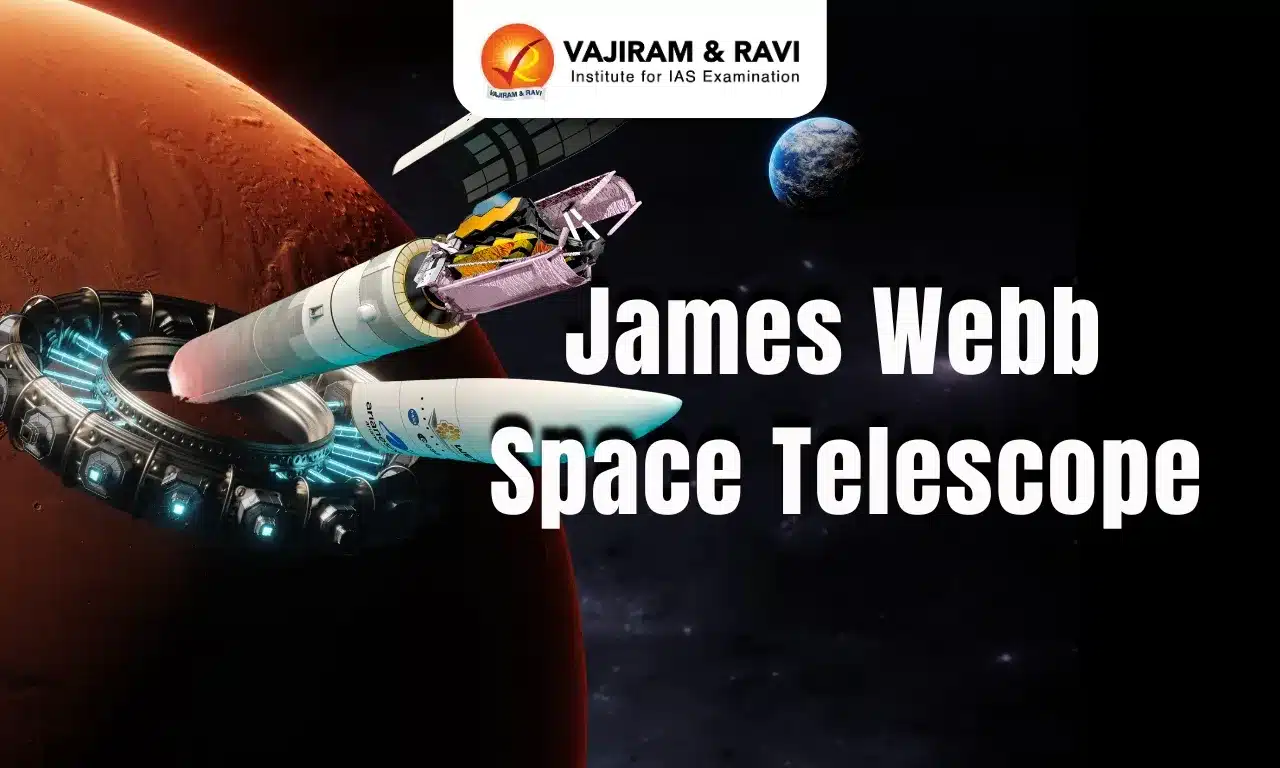The James Webb Space Telescope (JWST) is a monumental leap in space exploration and astrophysics. Launched on December 25, 2021, it is the largest and most powerful space telescope ever built, serving as the premier space-based observatory for the next decade. Developed by NASA with contributions from the European and Canadian space agencies, JWST is designed to observe the universe primarily in the infrared spectrum.
With its unprecedented resolution and sensitivity, the James Webb Space Telescope is like a time machine in space as it aims to probe the universe's earliest phases. JWST thus marks a new era in our understanding of the cosmos.
About James Webb Space Telescope
The James Webb Space Telescope (JWST) is a general-purpose observatory with a large aperture telescope optimised for infrared observations and a suite of state-of-the-art astronomical instruments capable of addressing many outstanding issues in astronomy.
Background of JWST
- Initiation and collaboration: The JWST project began in 1996 as a collaboration between NASA, the European Space Agency (ESA), and the Canadian Space Agency (CSA).
- Successor to Hubble: It has been conceived as the next-generation space telescope succeeding the Hubble Space Telescope, with a focus on infrared astronomy.
Features of James Webb Space Telescope
The JWST's features represent a significant advancement in space telescope technology, promising to deepen our understanding of the universe and its origins. Its key features are:
- Infrared optimisation: Designed primarily for infrared astronomy to observe objects which were too old, distant, or faint for visible light detection.
- Large primary mirror: Equipped with a 6.5-meter diameter primary mirror to capture more light and provide higher-resolution images.
- Segmented mirror design: The primary mirror comprises 18 hexagonal, gold-coated beryllium segments, thus enabling it to fold for launch and unfold in space.
- Sunshield protection: A five-layer sun-shield, which blocks solar light and heat, maintaining the instruments at extremely low temperatures necessary for infrared observations.
- Location at Lagrange Point 2 (L2): Operates from a stable orbit around the Sun-Earth L2 point thereby minimising light interference and reducing fuel consumption for orbital corrections.
- High sensitivity: Its instruments are highly sensitive to infrared light thus enabling the study of the earliest stars and galaxies formed after the Big Bang.
- Cryogenic cooling system: Uses a passive cooling system to reach temperatures as low as 40 Kelvin (-233°C) which is essential for infrared observations.
- Precision guidance sensors: Equipped with sophisticated guidance sensors for accurate pointing and stability. This is crucial for long-duration observations of faint celestial objects.
- Extended wavelength coverage: Capable of observing a wide range of wavelengths from 0.6 to 28 micrometres.
Objectives of James Webb Space Telescope
Its key objectives are:
- To look for galaxies that formed just after the Big Bang.
- To determine the evolution of galaxies from their creation to the present.
- To examine the stages of star creation till the formation of planetary systems.
- To investigate the potential for life in planetary systems by measuring their physical and chemical features.
Significance of JWST
The James Webb Space Telescope (JWST) offers numerous benefits for humanity in various ways:
- Advancing astrophysical knowledge: The telescope's detailed observations of celestial phenomena contribute significantly to astrophysics, providing new insights into the workings of the universe.
- Exoplanet exploration: James Webb Space Telescope’s study of exoplanets, including their atmospheres and potential for habitability, could answer key questions about the possibility of life beyond Earth.
- Educational and scientific collaboration: The international collaboration involved in JWST promotes global cooperation in science and education, uniting various countries and cultures in the pursuit of knowledge.
- Catalyst for future space missions: The success of James Webb Space Telescope paves the way for future space missions and telescopes, continuing the exploration of the universe in more depth and detail.
James Webb Space Telescope - Key Observations
- Galaxy cluster: A galaxy cluster that first formed 4.6 billion years ago, offering a glimpse into the early universe.
- Deepest infrared image: The deepest and most detailed infrared image, showcasing some of the oldest and most distant galaxies ever observed by scientists.
- The data from these images will enable scientists to gain deeper insights into the mass, age, composition, and evolutionary history of each of these ancient galaxies.
- Monster Galaxies: James Webb Space Telescope has identified six 'Monster' galaxies, which formed approximately 500-700 million years after the Big Bang.
- The identified galaxies are as old as the Milky Way, existing around 540-770 million years after the Big Bang, at a time when the universe was about 3% of its current age.
James Webb Space Telescope vs Hubble Telescope
The James Webb Space Telescope (JWST) represents a significant advancement over the Hubble Space Telescope in several key areas such as,
| Feature | James Webb Space Telescope (JWST) | Hubble Space Telescope |
| Infrared Capabilities | Optimized for infrared astronomy, allowing it to see through dust clouds and view redshifted light of distant galaxies. | Predominantly observed in the visible and ultraviolet light bands. |
| Mirror Size | Has a primary mirror 6.5 meters in diameter. | Has a primary mirror 2.4 meters in diameter. |
| Light-Gathering Capability and Resolution | Far more light-gathering capability and resolution, enabling the detection of fainter and more distant objects. | Less light-gathering capability and resolution compared to James Webb Space Telescope. |
| Location and Orbit | Located at the second Lagrange point (L2), providing a more stable vantage point and uninterrupted sky observation. | In low Earth orbit, which is less stable than L2. |
| Sensitivity | Higher sensitivity due to larger mirrors and upgraded equipment, crucial for studying distant galaxies, star formation, and exoplanets. | Lower sensitivity compared to JWST. |
| Instrumentation | Carries advanced instruments tailored for infrared observations, useful for studying exoplanet atmospheres and observing the earliest galaxies. | Instruments are less optimised for infrared observations. |
Other Space-based Observatories
Other than JWST and its predecessor, Hubble, the following are the other space-based telescopes (observatories).
- Chandra: Using X-ray photons, the Chandra X-ray Observatory has been observing some of the most unusual and far-off celestial occurrences since 1999.
- Astronomers were unable to observe the universe in this high-energy, short-wavelength light until they launched Chandra into space because Earth's bothersome atmosphere cuts out the majority of X-rays.
- SPHEREx’s: A two-year project called Spectro-Photometer for the History of the Universe and Ices Explorer (SPHEREx) is slated to survey the sky in both optical and near-infrared light, which is invisible to the human eye but a valuable instrument for addressing cosmic mysteries.
- It will be introduced in 2024.
- The mission will be used by astronomers to collect data on over 100 million stars in the Milky Way and over 300 million galaxies.
Last updated on November, 2025
→ Check out the latest UPSC Syllabus 2026 here.
→ Join Vajiram & Ravi’s Interview Guidance Programme for expert help to crack your final UPSC stage.
→ UPSC Mains Result 2025 is now out.
→ UPSC Notification 2026 is scheduled to be released on January 14, 2026.
→ UPSC Calendar 2026 is released on 15th May, 2025.
→ The UPSC Vacancy 2025 were released 1129, out of which 979 were for UPSC CSE and remaining 150 are for UPSC IFoS.
→ UPSC Prelims 2026 will be conducted on 24th May, 2026 & UPSC Mains 2026 will be conducted on 21st August 2026.
→ The UPSC Selection Process is of 3 stages-Prelims, Mains and Interview.
→ UPSC Result 2024 is released with latest UPSC Marksheet 2024. Check Now!
→ UPSC Prelims Result 2025 is out now for the CSE held on 25 May 2025.
→ UPSC Toppers List 2024 is released now. Shakti Dubey is UPSC AIR 1 2024 Topper.
→ UPSC Prelims Question Paper 2025 and Unofficial Prelims Answer Key 2025 are available now.
→ UPSC Mains Question Paper 2025 is out for Essay, GS 1, 2, 3 & GS 4.
→ UPSC Mains Indian Language Question Paper 2025 is now out.
→ UPSC Mains Optional Question Paper 2025 is now out.
→ Also check Best IAS Coaching in Delhi
James Webb Space Telescope FAQs
Q1. What is the James Webb Space Telescope?+
Q2. What are the main goals of the JWST?+
Q3. How is James Webb Space Telescope different from the Hubble Space Telescope?+
Q4. Where is the James Webb Space Telescope located?+
Q5. Who developed the James Webb Space Telescope?+



















